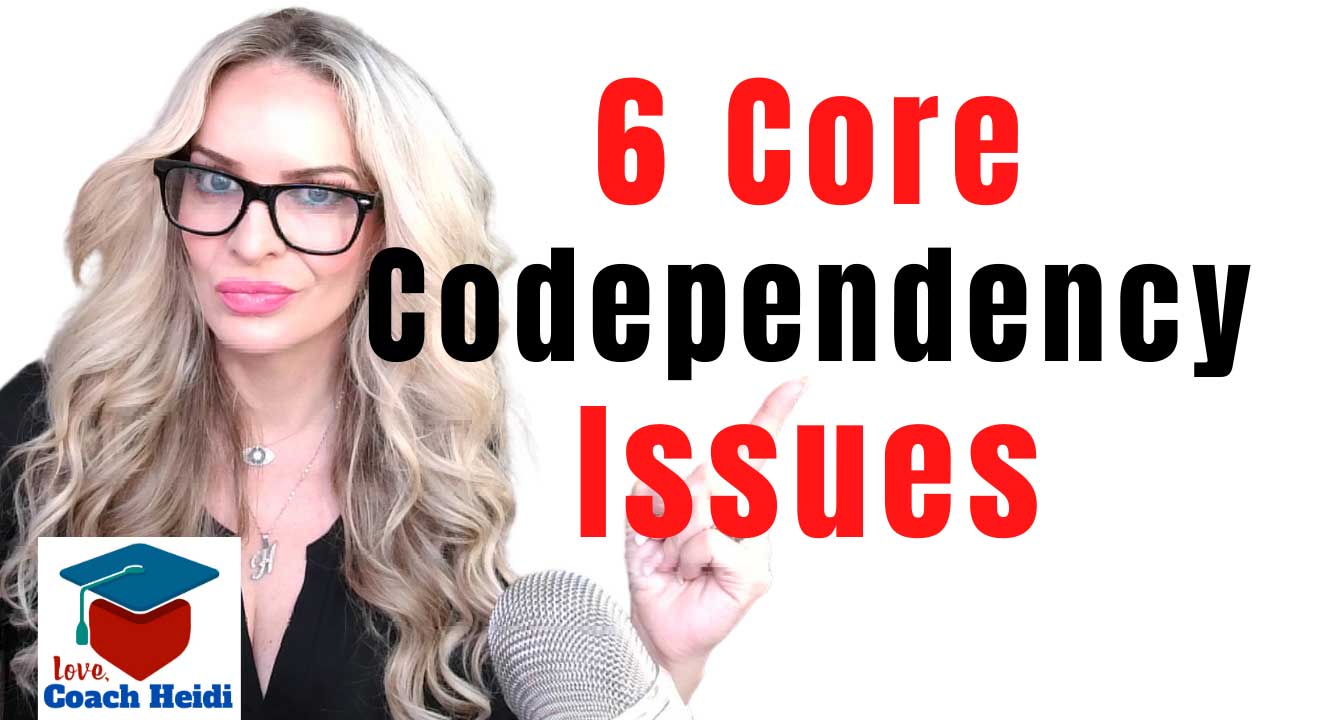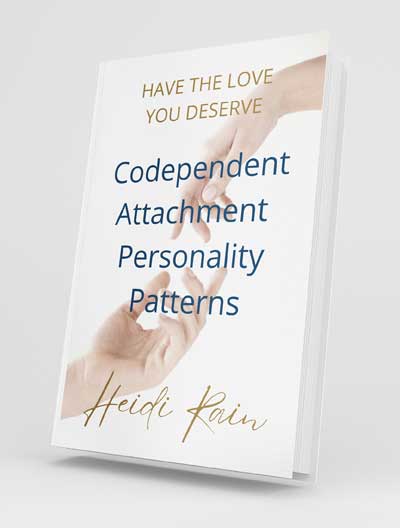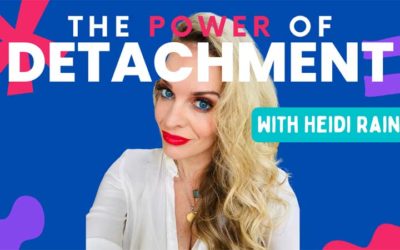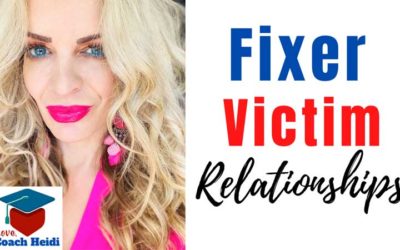What are the Core Issues of codependency?
I get asked that question so much and it’s because codependency is still one of the most misunderstood things in the world of relationships. And so, my goal is to help you make sense. To teach things in such an easy way that you can understand your unique codependency patterns, your partner’s patterns, or other relationships that you have. Why? So that you can have the relationships that you deserve. Relationships that aren’t full of drama, resentment, confusion, where you are scratching your head wondering how to strategize or get this thing to work. That’s all codependency.
I know that codependency and the issues that you are having are really leaving you full of resentment, confusion, anxiety, pain. And ultimately our work is about breaking you free. Psychological freedom so that you have control over your own thoughts, and your mind isn’t hijacked. Constantly obsessing or worrying. Emotional freedom, where you don’t feel like you are on a love roller coaster. Constantly up and down and all over the place.
Let’s dive in. These are the six basic core issues that we have when we are codependent.
The first issue is the overarching issue that encompasses all of codependency and that’s the issue of “Identity.”
Codependency is I don’t know who I am because who I am is not good enough.
It’s not working for me to be me. So, I need to figure out who I need to be to function in this dysfunctional relationship.
What we do is we take on a way of behaving. A way of being. A personality if you will, so that we can connect, cope, survive, or thrive in this dynamic.
We take on a personality and eventually we literally don’t know who the hell we are. We scratch our heads, and we are like, I don’t know who I am. I’m a chameleon. And that’s true of codependence. You are a chameleon. You can fit in anywhere. And in fact, a lot of my students and clients, what we end up doing is when we get into a situation, a relationship, we survey the land. We look around and we do a lot of observing about who people are and we get the lock on everybody. We understand and then we say, how can I fit in to this dynamic? Who do I need to be to be okay, be liked, be respected, be whatever in this dynamic?
With codependency there’s an awful lot of strategizing that goes on. It’s like you can’t give yourself permission to just walk into the room and be who the hell you are. Because you don’t know how that’s going to be received. And again, when you grow up in a dysfunctional dynamic, and codependency is a lifestyle from an early age. It’s a pattern you took on a long time ago. It really was a survival skill. That you needed to survey the land to figure out who you needed to be so that you didn’t get hurt. Or you could cope or survive or whatever it was you were trying to do. So, these patterns, it’s not a bad thing all the way. Because at first, these patterns really kept you safe. They helped you. It’s a problem now because you want to be your true self. You want to figure out who the hell you really are.
A lot of us are at a certain point of our life where we are freaking tired of being who we need to be for everybody else.
We really do just want to have full permission to let ourselves be unleashed and be all of who we are.
An identity crisis is the first thing we suffer from in a codependent relationship. Who am I? Now for you to figure out who you are, you need to figure out first, who you’ve been and who you are not.
That’s by the process of elimination, right? Because you are not lost. You don’t need to find this version of you. You need to excavate her or him. You need to uncover by removing the masks. The masks that you’ve put on, are what I have named Attachment Personality Patterns.
Of course, my signature group coaching program called LYFE School is all about unraveling that patterning so that you can really be your authentic true self. Because here is the deal, you can’t have true love if you are not your true self.
You can’t feel fully seen, respected, loved, or adored if you are not yourself. Because they are not really loving you. And you feel that disconnect, don’t you? You know that you are not being loved for who you really are because you are not really being your authentic self.
You are being who you need to be. So “Identity” is the first issue.
The second issue, core codependency issue that we have and how it shows up is “Control Issues.”
Now, codependency tends to be all or nothing, black or white. And we can vacillate on opposite ends of the spectrum. However, it’s the same issue.
I’ve heard a lot of people say, “well I’m not codependent but my husband is.” “I’m not codependent but she definitely is codependent.” Well, what is “co?” What’s codependent? Are two people, right? Two people. So, we might not think we are codependent. They are codependent not us, but the way the reality is, it takes two.
Control issues manifest one or two ways. You are in charge. It’s your way or the highway. You want to tell people how to think, how to feel, how to behave. Now, here’s the thing, controllers aren’t malicious unless they’re pathological and then they turn into narcissistic personality disorder.
But I don’t deal in disorders or pathology. I deal in patterns. As a coach, that’s a very different perspective.
I’m not telling you that you are broken, or you are sick, or you have a diagnosis. I’m telling you this a pattern. So, I’m going to take the approach that this type of controller isn’t pathological. They are doing it because it’s more benevolent.
You are controlling because you think bad things are going to happen if you don’t. Now this can be problematic, obviously. When people can feel like you are always trying to control them and tell them what to do and how to think and how to behave and you are anxious a lot. Walking around like hypervigilant, making sure everything’s okay. This with a controller, feelings of complete and total overwhelm is probably the biggest issue that controllers feel in addition to resentment when people don’t take the advice that we are giving them or follow through.
But a controller will also manipulate, they’ll strategize. They figure out here’s how I need people to behave. How do I get them to behave the way I want them to behave? Controllers play a lot of games in relationships.
Now on the other side of that spectrum of control, is people who allow others to control them. And they end up in a People Pleaser Pattern versus a Controller Pattern, though they both have control issues.
They let other people tell them what they think and how to feel and they look to other people.
A people pleasing codependent feels as though they have no control. They go with the flow. They are complicit, compliant, doing whatever needs to be done, unwilling to rock the boat or break any eggs.
As far as control issues go, like attracts like but on the opposite end of the spectrum. A Controller Pattern and a Pleaser Patterns hook up.
And this is a match made in hell because these two are feeding off each other in this dynamic and they are both tired of it. Controllers often will say, “I just want you to tell me what you want, and I just want you to step up. I don’t want to be in control all the time. I don’t want to have to be the one all the time.” And a pleaser says, “Just tell me what you want me to do. And I’ll do it.” They are afraid to be in control and make a mistake.
One is afraid of being in control and the other is afraid of being out of control.
What does healthy control look like? The middle Way.
The middle way is a very Daoist, it’s a very Buddhist philosophy. It’s not all or nothing. And codependents need to learn that it’s not black and white. There is a middle way. So, what would the middle way look like between a controller and a pleaser? It would look like we meet in the middle. I control what I can and I back down when I need to, and I let other people do their thing. I encourage other people to have their own thoughts and own opinions and I take no shit, but I’m still kind.
In LYFE School we work on these core issues.
The next issue is, “Self-Esteem Issues.”
At the root of all co-dependency issues is this core issue of self-esteem regulation. And for many people, the Attachment Personality Patterns are a way to regulate our self-esteem. Every single pattern is about regulating self-esteem. And I’ll talk about two patterns and how we regulate that self-esteem first. One is perfectionism. Many of us learned early on that to have love or approval, we need to be perfect.
We are not allowed to make mistakes and so we put an extreme amount of pressure on ourselves and other people to live up to this crazy standard that we’ve set for ourselves and everybody else. We fall short, they fall short, but I’ll tell you a perfectionist pattern has a real hard time owning their own shit.
They are very adept at looking at other people much like the fixer pattern. The perfectionist, also like the fixer has a problem seeing themselves, because it’s all projected onto other people. But a perfectionist does judge themselves very harshly.
That’s the difference, right? Where a fixer feels like they have it all together, most of the time a perfectionist behind closed doors really does feel terrible. But to regulate that self-esteem, they just aim higher. They just keep on setting that goal and that standard and they never quite reach it, of course. A lot of perfectionists procrastinate.
They never really get the thing done that they want to do because they can’t do it the right way. Nobody else is doing things the right way.
When I have a perfectionist in my program, and they’ll say things like “Did I do the right thing?” They want to do thing right because if they do it right then they are going to be good and that’s the goal underneath. Perfectionists don’t feel good unless they are perfect. And you can imagine when they do make a mistake, their whole world crumbles and falls apart.
There’s very little room for other people to have their own opinions or thoughts about how to do things because the perfectionist is like, “I know exactly what you need to do or how we should do this.”
Another self-esteem regulator shows up, is in the Pretender Pattern. Sometimes I call the Performer. Which is, I put on a show. I suck it up. Now this is a person who is very concerned about appearances, not necessarily integrity. They will lie just to look good. They will do whatever they need to do to make sure that they are perceived a certain way. They want to curate their image.
Through a Pretender may be struggling significantly, they feel “The show must go on”.
The next core issue we are going to talk about is “Trust Issues.”
Back to our personality patterns to take a deeper look at this issue. Two patterns, same issue, opposite sides of the spectrum
A Withholding Personality learned very early on that vulnerability is for the weak. It’s kind of like a pretender and a performer, except Withholders are extremely sensitive people. They feel things very deeply, but their biggest fear is that you are going to hurt them. Because they don’t want you to use their vulnerability or weakness as they see it, against them, they withhold their feelings. They withhold their thoughts.
They withhold their feelings from you because they don’t want you to have access to them. A withholder wants intimacy so deeply, but they are so afraid of being rejected at the end of the day, that they kind of keep people at an arms distance.
Now on the other side of that spectrum of trust issues is the Clinger. They over trust.
The Withholder under trusts and the Clinger over trusts.
A clinger is a ride or die. They are loyal to a fault. And these two patterns hook up.
Withholders love a clinger because at first, they don’t have to share anything because a clinger overshares. They are oversharing and dominating.
A withholder really likes that at first, right? Because it feels good. Because again, remember their biggest fear is being rejected. So, clingers make them feel good.
But after a while, a withholder will start to feel very smothered by a clinger and they will start to pull back and a clinger’s biggest fear is abandonment. That’s why they ride or die. They will stay with anybody because that’s better than being with nobody.
Clingers also don’t recognize the emotional unavailability of the people they are attracted to. Withholders are not emotionally available, but a clinger doesn’t see that, they just fantasize. They project “this is the one. I’ve never felt this way before.”
A clinger is so wrapped up in the ideology and the fantasy of the relationship that they fail to see the reality of the person that they’re with.
And so now, when the withholder starts to pull away, they trigger up the clinger’s abandonment issues. And the clinger clings harder and then the Withholder feels totally smothered. They pull away even more.
Then eventually a clinger says, “okay, you know what? I’ve had enough of this. I’m out of here.” And the clinger pulls away and the Withholder goes, “where are you going? Don’t leave me”. Because now their rejection is triggered up. They chase after the Clinger and they can do this dance for decades, clingers and withholders.
I’m sure at this point you can see how rich this content is. There are three levels when you are working with me. The first is beginner, where you identify what pattern, you are and you see how you are operating and that’s level one.
And that is crucial. You can’t miss this. You’ve got to have insight into yourself and your partner. You’ve got to nail your pattern.
And by that in LYFE School we take that pattern and do a whole process to understand how that pattern shows up for you. What behaviors you exhibit. What are your trigger feelings? Where did it come from? And it’s a lot of work.
Level two is apprentice. And this is where you start to practice Detaching rom the Patterns in your daily life. You start to see so much more. You can point out other people’s patterns quicker. You can bypass the patterns. You see the flags come in. You know who to be with, who not to be with. You take that knowledge that you get in beginner and you put it into motion and action in your everyday life and you become an apprentice.
And then level three of understanding is mastery and this is for many people who want to go the whole way and become a coach with me. They have a mastery of this information. They’re living it and they master it so that they can teach other people and help other people.
The next core issue with co-dependency is “Emotions”.
Now, how you can identify if you’re co-dependent isn’t just through the behaviors or identifying your patterning, which is crucial. That’s the first step. But your emotions are another barometer that you are codependent.
What emotions are you experiencing on a regular basis? Resentment, confusion, pain, anxiety, abandonment, rejection?
When you’re trapped in your pattern, you feel these feelings on a regular basis.
Emotion as a core issue for codependency manifests one of two ways: Repression or Dysregulated Expression.
A Withholder suppresses emotions and has trouble identifying feelings.
A pleaser has repressed their feeling for so long that they don’t have access to what they need or want anymore.
A controller attempts to tell others how to feel.
A perfectionist condemns and judges feelings.
A clinger’s emotions are a whirlwind that sucks others in.
A victim lives in unresolved, unprocessed, unrecognized pain.
A pretender sucks up other feelings
A fixer worries about and feels responsible for everyone else’s feelings.
And the ne thing they all have in common is that eventually, emotions take us over and we reach a breaking point,
Our Codependency recovery program is geared toward learning how to identify your emotions, be in your emotions, feel your emotions and learn how to effectively express and communicate them
So many of us are so focused on other people that we do not know how we feel. We are so used to turning off our feelings, or we’ve been gas lit. Many of us who grew up in dysfunctional, toxic, abusive households, addicted households, got the message early on that your feelings don’t matter. It doesn’t matter how you feel. Or it wasn’t safe for you to feel. So, you learned how to disassociate or shut off your feelings.
Codependency recovery is a walk back home to your own sensitivity. It’s learning how to feel those feelings again and express those emotions properly and appropriately for you. And learn how to communicate those emotions to people
The last core issue is Responsibility.
As I have stated earlier, codependency is black and white. You are over responsible or under responsible. And here are the two patterns we enact. If you’re overly responsible, you’re a Fixer Personality. You think their problem is your problem. You have caseloads instead of friends. You take on more. Put on your cape and run to the rescue.
On another side, you’re totally irresponsible and you are a Victim Personality.
The Victim takes no responsibility at all whatsoever.
What do they do? They blame everything and everybody else for their problems. They have an excuse for everything. They minimize their problems. They justify their problems. Excuse, rationalize, project their issues on other people.
A victim takes no responsibility, and a hero takes all the responsibility.
Fixers and victims are peas in a pod, partners. They attract one another.
So how do you resolve these core issues?
That’s the purpose of LYFE School. Love Yourself First Empowerment. We work together to resolve these core issues.
You resolve the issues of control. Meet in the middle. Learn what’s yours and what’s other people’s.
Same with responsibility. Trust, learn how to develop that divine intuition. Trust yourself, your judgment. Open up, receive from other people. Stop being the giver and other people the taker. You learn how to receive for once.
Self-esteem issues. You feel good about yourself at your core.
You know who you are. You are not confused about your identity anymore. How awesome is that? That’s recovery and that’s what we are working towards. And for the committed people who say, “This is my time. I want to take my life and own it. I want to plug up the power leaks that I have in my life with the people sucking my power. The places I don’t want to be sucking my power. The things in my life that are sucking my power.”
Imagine what you would do if you plugged up that leak and took all that power back. You would be able to manifest your life on your terms, exactly the way you want it, and you know, what’s so true? You deserve that! You’re a good person. Now’s your time. So, let’s get to work. What core issues are you working on? What are the core issues that resonated with you the most? What core issues do you want to tackle first?
Go to






0 Comments